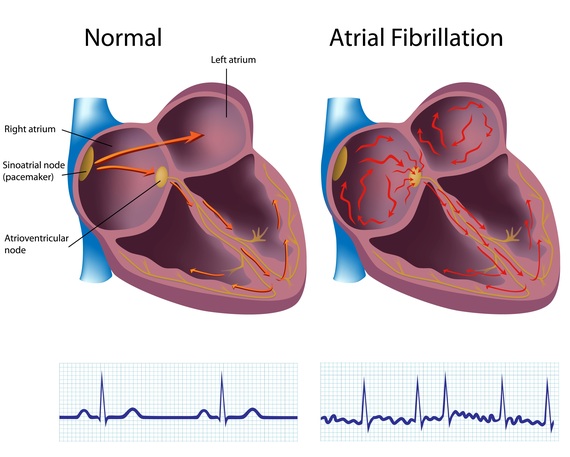Somewhere between 2.7 to 6.1 million people in the United States have AFib -- atrial fibrillation. And there are 25 million adult Americans with obstructive sleep apnea (OSA). Every week I feel like a solid 1 percent of them walk into my office with both heart arrhythmia and OSA -- and don't know it. And not knowing may be life threatening.
At present, patients with heart rhythm abnormalities show up for sleep consultations with increasing frequency. We are seeing the patient who has new onset of atrial fibrillation, has a recurrence of AFib or is experiencing cardiac arrhythmia. Given the risk of OSA to their heart rhythms, evaluating those patients for OSA is a necessity.
The OSA/AFib patient profile
My typical patient is a middle-aged man -- or woman, there is no gender discrimination here -- who is having night sweats or an abnormal heartbeat at night, and, understandably, can't sleep! Or those same patients frequently show symptoms for sleep apnea such as snoring, daytime sleepiness and a large neck circumference -- 17+ inches in a man and 16+ inches in woman. Notably and importantly, some patients only present with the signs of atrial fibrillation and frequently are unaware of sleep issues.
Sometimes the patient has been evaluated for AFib; his physician has sent his Holter monitor readings to me and they show irregularities, but not AFib. (A Holter monitor is a portable device that records the heart rhythm continuously -- usually for 24 hours -- through chest electrodes.) Even though there is no diagnosis of AFib, there are abnormal heart rhythms at night. Combined with the other factors, I am confident my new patient is on his or her way to a sleep test.
AFib and the middle-aged heart
AFib is a heart arrhythmia where the top and bottom chambers of the heart beat out of synch and with an irregular rhythm. AFib is more common in middle-aged and older individuals and symptoms include irregular heartbeat, palpitations -- fluttering or pounding heart -- lightheadedness, extreme fatigue, chest pain and shortness of breath. AFib can be episodic where an individual experiences transient symptoms. Or it may be chronic, with permanent irregular heart rhythm.
The risk of stroke for a person with AFib is 4-5 times higher than for those without. Strokes caused by AFib complications are more severe than strokes from other causes, and AFib causes 15-20 percent of ischemic strokes, where blood flow to the brain is blocked by a clot or plaque from blood vessels.
So what do AFib and OSA have in common?
Now consider obstructive sleep apnea (OSA). Individuals with OSA -- which increases in occurrence between midlife and older age -- decrease or completely stop breathing in their sleep, despite their bodies efforts to continue to breathe. The interruptions in breathing range from 10 to 30 seconds, but some last for a minute or longer! The accompanying abrupt drop in oxygen causes the brain to alert the body to start breathing again, usually with choking or gasping as the airway reopens. This pattern can occur hundreds of times each night causing marked stress and irritability to the patient in general and the heart in particular.
Some of the effects of OSA are increased heart rate, chronic elevation in blood pressure, increased risk of stroke and higher death rate due to heart disease.
This overlap between the risks, symptoms and health consequences of AFib and OSA is a big tip-off to the diagnostician and the clinician: where you find one you will often find the other!
Recent research has been strongly supportive of the clinical need to check AFib patients for OSA, with sleep tests as necessary, and to treat with CPAP (continuous positive airway pressure device) as indicated.
"... It seems that AF is a well-established consequence of sleep-disordered breathing ... studies found a higher-than-expected prevalence of AF among patients with OSA and more OSA among patients with AF ... OSA seems to decrease the efficacy of chemical cardioversion, electrical cardioversion, and catheter ablation; similarly, recurrence of AF is significantly more common among patients with untreated OSA, whereas CPAP therapy seems to mitigate this risk."
"The use of CPAP is associated with significant reduction of AF in patients with OSA. This effect remains consistent and similar across patient populations regardless of whether they undergo PVI (pulmonary vein isolation)."
What to do?
First, recognize that AFib and OSA are both very treatable, so stay positive! The point here is to get you healthy and keep you healthy.
If you experience irregular heartbeat, fluttering, palpitations, your heart beating too hard, it is definitely time for your primary care physician to check up on your symptoms and possibly refer you to a cardiologist. Be certain to tell your doctor if you have daytime sleepiness, morning headache or snore excessively. From the sleep apnea side, your heart rate and rhythm are routinely monitored among the parameters measured as part of your sleep test.
AFib and OSA alone and together are serious health issues, but with proper treatment and consistent adherence to your program of care, you can feel great and live a healthy life.
